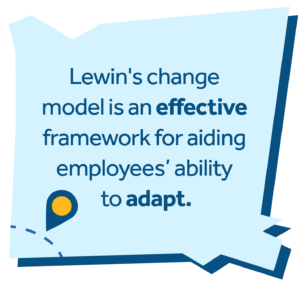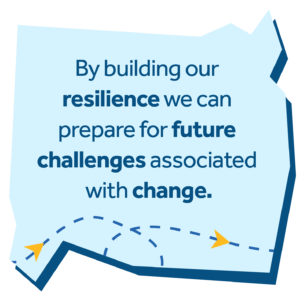So, ice baths. They sound like torture to me! But apparently there’s a valid argument for this bizarre concept and it relates well to the way we manage change…
The cold therapy trend is clearly a popular one, with the first electric cryotherapy chamber having recently opened in the UK for people to enjoy regular sessions at -120c!
I wanted to understand what would possess people to expose themselves to these icy blasts or choose to stand shivering under a chilly shower for increasing periods of time.

Stimulated by stressors
Turns out it’s all about hormesis – these ‘positive stressors’ enable us to push beyond our comfort levels and adapt to change. With the right intensity, a stressor can make us physically and mentally stronger and healthier, and primed for a deeper impact on the next exposure.
It’s interesting how this icy analogy can be likened to the way we build psychological flexibility, not only to face personal challenges but also the continual change we experience at work.
A chilly approach to workplace change
From preventing injury to improving mental health, cold therapy offers plenty of ways to build resilience. Which is something that goes a long way to preparing for and adapting to change!
Kurt Lewin’s change model has been around for decades yet it holds true today as an effective framework for aiding employees’ ability to adapt. The three distinct phases break down those iceberg sized change chunks into more manageable stages. 
Phase one: Unfreeze
Firstly we ‘melt the ice’ to make it open to change and create motivation. This first part of the process is usually the most difficult and stressful – something new and different is coming so we’ll need to brace ourselves. Like the moment we plunge into that icy water for the very first time, we’re preparing for future challenges and teaching ourselves to stay calm under pressure.
While we won’t be pouring a giant freezing bath for employees to hop into, as comms pros, there are some things we can do to help them prepare for change:
- Create and share a compelling message about why the change has to happen despite the discomfort we may be feeling.
- Emphasise the “why”, communicating the vision in terms of the change required.
- Remain open to employees’ concerns, listen attentively, and address their issues in terms of the need to change.

Phase two: Change
With a few frosty showers under our belts, we’re feeling energised and our resilience is building. We’re starting to work with the change and tiptoe towards our new ways of working and being. We’re feeling physically and mentally able to start resolving those initial uncertainties, beginning to believe and act in ways that support the new direction.
As comms pros we can help to maintain momentum and avoid slipping back into the warm waters of familiarity by:
- Explaining how the changes will continue to affect everyone and how we intend to navigate through the discomfort of them
- Staying ahead of rumours and dispelling them – answer questions honestly, deal with problems openly, and relate the need for change back to operational necessities.
- Empowering people by involving them in the process, where appropriate, and providing line managers with the tools they need to give day-to-day direction.

Phase three: Refreeze
This final stage of the change involves ‘refreezing and embedding’ into our new state. Having practiced our icy dunking to perfection, we’re primed for a fresh new beginning, and feeling ready to deal with the days ahead. As seasoned experts, we’ve become the winning Wim Hofs of the workplace!
With a greater sense of clarity and stability now, people have embraced the new ways of working and are feeling comfortable with the latest BAU. To firmly anchor these changes into the organisation’s culture, comms pros can support by communicating clearly about the new state, and how the changes are being incorporated into the everyday.
We can also help by:
- Ensuring leadership support and keeping the SLT visible as they role model the new behaviours that support the change.
- Maintaining feedback systems and keeping two-way lines of communication open.
- Celebrating successes big and small to demonstrate how people are working through the discomfort and winning!
Confronting change with confidence
Facing change means stepping away from the comforting warmth of familiarity. But by building our resilience to prepare for what’s to come we can thaw the frosty thoughts that hold us back.
“If we always choose comfort, we never learn the deepest capabilities of our mind or body. It is moments like this that we need to face our fears. The best way to have such a moment is to gradually confront the fear and approach it in a way that is both exciting and inspiring. You have to be decisive and physically prepared to do your best. After that, little by little, you will see progress.” | Wim (The Iceman) Hof
By Caroline Roodhouse for Alive!
















